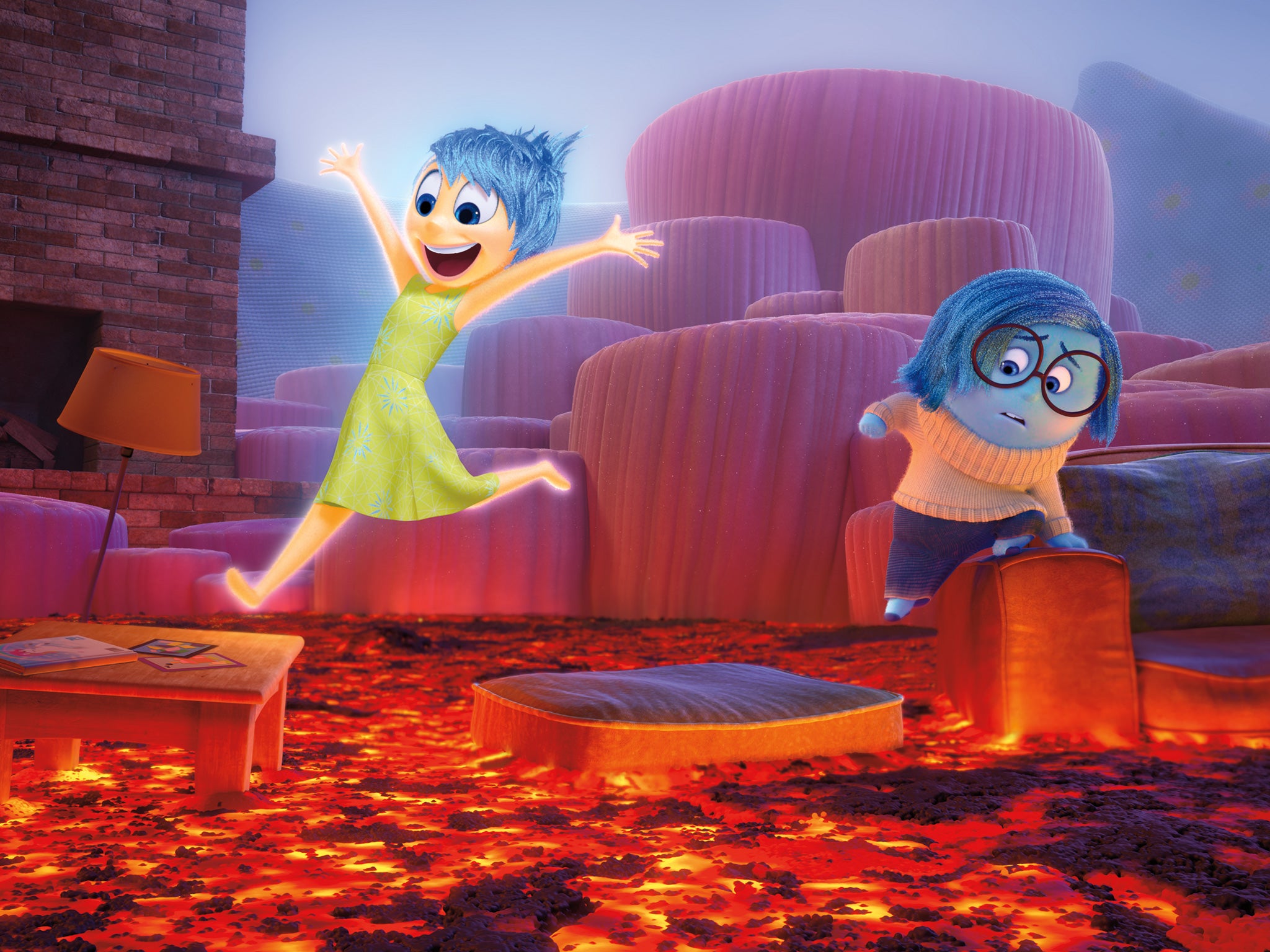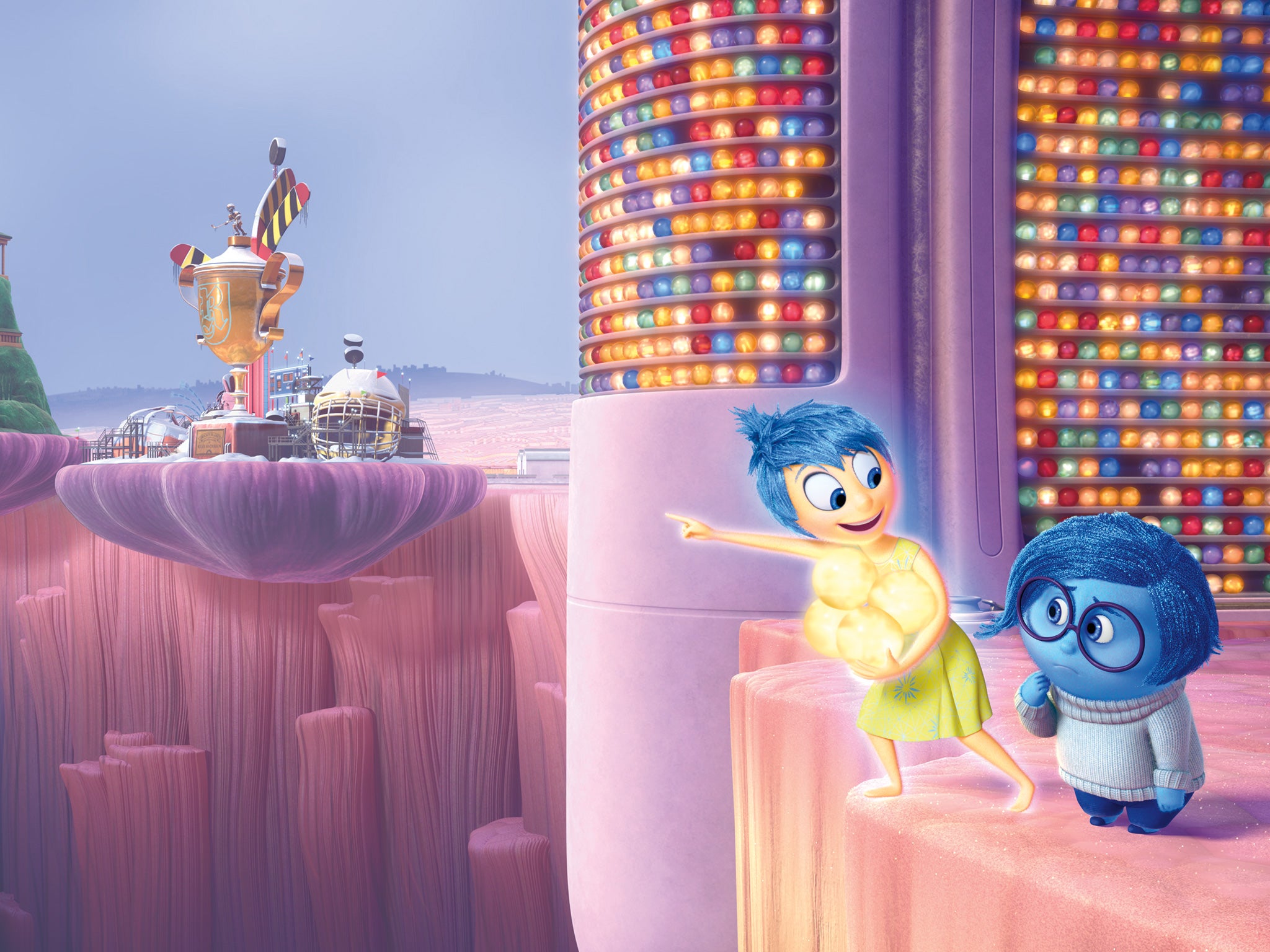Inside Out, movie review: Pixar’s latest and boldest feature is going to be an instant classic
(U) Pete Docter, 102 mins, voices: Amy Poehler, Bill Hader, Lewis Black

Generally, when Hollywood deals with the unconscious, the spectre of Dr Freud (“an elderly gentleman from Vienna inflicting his dreams on me” as novelist Vladimir Nabokov called him) looms over proceedings. One of the delights of Pixar’s wholly wonderful new animated feature Inside Out is that Freud is banished to the sidelines. Director Pete Docter is able to take us inside a little girl’s mind without enlisting a white-bearded psycho-analyst as our chaperone.
There are two parallel worlds in the movie: everyday, external “reality” as experienced by 11-year-old Riley (voiced by Kaitlyn Dias) and what is going on in her head. Against her will, Riley has just moved from her home in Minnesota to San Francisco, where her father’s work has taken him.
Riley’s moods are regulated by a team of five imps who operate in a control room behind her eyes. The ringleader, who has a hint of Tinkerbell about her, is Joy (voiced with relentless enthusiasm by Amy Poehler). True to her name, she is effervescent and endlessly upbeat. Her skin glows and we can even see the furry down on her arms. Her colleagues are Anger, a fiery red weetabix-shaped figure with a passing resemblance to Square Bob Sponge-Pants; Disgust, a green punkish Amazonian with a virulent hatred of broccoli; Fear, a nervous type who dresses like a provincial librarian, and Sadness, a moping, bespectacled young woman with pale blue skin and a very chunky, Clancy brothers-style woollen jumper.
Like all the best Pixar films, Inside Out manages the delicate feat of being worldly wise without ever sacrificing its sense of innocence. The heroine may be on the cusp of adolescence but the button marked “puberty” isn’t pressed. (It’s enough for it to be there.) In one scene, which sums up the upheaval of young love in a nutshell, she smiles at a boy whose mind almost short circuits in attraction and terror at the sight of her.
We’re given glimpses inside the heads of Riley’s parents. Her mom is still harbouring romantic thoughts about a handsome Brazilian helicopter pilot while her father distractedly daydreams about sport.
The filmmakers throw in a few discreet Hitchcock references. At one stage, somewhere in a section of Riley’s head called “Dream Productions,” we see a Saul Bass Vertigo-style poster for an imaginary film called “I Am Falling For A Very Long Time Into A Pit.” Another in-joke for the grown-ups has the travellers in Riley’s unconsciousness coming across an entrance with the wording - “danger, abstract thought.” This is a realm where objects and characters fragment, as if they are subjects in a cubist painting.
At the same time as they wink at the adult audience, Docter and his team have made their film immediately accessible to very young audiences. The unconscious as portrayed here is a brightly coloured cavalcade of experiences and memories. Its locations include such places as Goofball Island, Honesty Island, Friendship Island and Family Island. It is when these islands begin to sink that the panic starts.
Early on, you can’t help but wonder how on earth Docter and his collaborators are going to create a feature-length narrative from the inside of Riley’s head. The trick is to have Joy and Sadness flung to the farther recesses of her mind. In Joy’s absence, there is no-one to moderate the little girl’s behaviour or to pep her up. She becomes increasingly wretched and her yearning for the old life she enjoyed in Minnesota intensifies.
We follow Joy and Sadness as they desperately make their way back to Headquarters to rescue Riley. It’s an epic journey across a phantasmagoric landscape. They travel by foot and by every other means of transport, including the “train of thought,” which, needless to say, goes all over the place. Their companion for some of the journey is Riley’s “imaginary friend” Bing Bong, a pink, fluffy beast who is part dolphin, part elephant and with a bit of circus clown thrown in for good measure, and who could easily have stepped straight out of the pages of Dr Seuss or Lewis Carroll.

Watch Apple TV+ free for 7 day
New subscribers only. £9.99/mo. after free trial. Plan auto-renews until cancelled.
ADVERTISEMENT. If you sign up to this service we will earn commission. This revenue helps to fund journalism across The Independent.

Watch Apple TV+ free for 7 day
New subscribers only. £9.99/mo. after free trial. Plan auto-renews until cancelled.
ADVERTISEMENT. If you sign up to this service we will earn commission. This revenue helps to fund journalism across The Independent.

Inside Out is a movie for the online computer age. It reflects a world in which consciousness is perceived almost as if it is a computer hard drive and emotion as something that can be expressed by hitting buttons on a keyboard. Not that Riley is surrounded by gadgets. She has a cellphone but we don’t see her playing on a laptop or video game console.
What hasn’t changed at all in family movies from The Wizard Of Oz days to Inside Out is the notion that “there is no place like home.” Home here is a state of mind, not a location. What it really means, both for Riley herself and for her five “emotions,” is togetherness. If you’re with mum and dad, you can keep the outside world at bay.
The “inside” here is far more vivid than the out. The best gags and the most lively animation are all reserved for the scenes set within Riley’s mind. The exterior, San Francisco-set material is far blander and markedly less inventive.
Kids and their parents, psychologists and philosophers alike, are all bound to be equally intrigued and delighted by Pixar’s latest and boldest feature yet. It is the universality of the film that makes it an instant classic. Inside Out combines simplicity with extraordinary formal daring and sophistication. It is very funny, too, and, best of all, it comes without any of the guilt or shameful foreboding that a certain Viennese doctor might have lumbered it with if he had been let loose on Riley’s mind.
Join our commenting forum
Join thought-provoking conversations, follow other Independent readers and see their replies
Comments